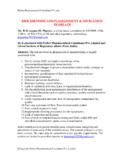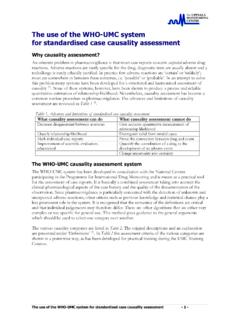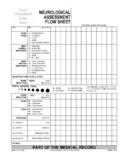Transcription of MERCURY IN SKIN LIGHTENING PRODUCTS - WHO
1 PREVENTING DISEASE THROUGH HEALTHY ENVIRONMENTS. MERCURY IN SKIN LIGHTENING PRODUCTS . MERCURY is a common ingredient found in skin LIGHTENING soaps and creams. It is also found in other cosmetics, such as eye makeup cleansing PRODUCTS and 3 Skin LIGHTENING soaps and creams are commonly used in certain African and Asian ,4,5 They are also used among dark-skinned populations in Europe and North ,6,7 MERCURY salts inhibit the formation of melanin, resulting in a lighter skin ,9. MERCURY in cosmetics exists in two forms: inorganic and ,10,11 Inorganic MERCURY ( ammoniated MERCURY ) is used in skin LIGHTENING soaps and creams. Organic MERCURY compounds (thiomersal [ethyl MERCURY ] and phenyl mercuric salts) are used as cosmetic preservatives in eye makeup cleansing PRODUCTS and 3,12.
2 Use, production and availability In Mali, Nigeria, Senegal, South Africa and Togo, 25%, 77%, 27%, 35% and 59% of women, respectively, are reported to use skin LIGHTENING PRODUCTS on a regular In 2004, nearly 40% of women surveyed in China (Province of Taiwan and Hong Kong Special Administrative Region), Malaysia, the Philippines and the Republic of Korea reported using skin In India, 61% of the dermatological market consists of skin LIGHTENING Skin LIGHTENING PRODUCTS are manufactured in many countries; for example, consumer protection agencies in the European Union13 18 and the United States of America (USA)19,20 have identified MERCURY -containing PRODUCTS made in China,13,16,19,20 the Dominican Republic,1,19 Lebanon,13,21 Mexico,19,22 Pakistan,13,14 the Philippines,13,15.
3 Thailand,13,17,23 and the ,18. MERCURY -containing skin LIGHTENING PRODUCTS are available for sale over the Internet. A 2011 survey funded by the German Federal Ministry for the Environment, Nature Conservation and Nuclear Safety noted that individuals from Brazil, Kyrgyzstan, Mexico and the Russian Federation believe that MERCURY -containing skin LIGHTENING PRODUCTS are easy to Some manufacturers are no longer using MERCURY as a preservative in mascara and eye makeup cleansing PRODUCTS as a result of consumer pressure. However, most jurisdictions still allow the sale of makeup PRODUCTS containing MERCURY PRODUCTS , packaging and ingredients Skin LIGHTENING PRODUCTS come in different forms, including soaps and creams; the soap is often sold as antiseptic soap.
4 1,2 These PRODUCTS are supposed to be applied to the skin to dry Women use the soap to wash their hair, arms or face or their entire It is reported that some women use these PRODUCTS for as long as 20 The soaps come in bar form and are sold individually in The creams are generally packaged in tubes or The soaps contain approximately 1 3% MERCURY iodide, and the creams are composed of 1 10% MERCURY Some soap PRODUCTS tested contained MERCURY at concentrations up to 31 mg/kg, whereas cream PRODUCTS had MERCURY concentrations as high as 33 000 PRODUCTS with very high levels of MERCURY contamination look grey or cream The amount or concentration of MERCURY in a product may be labelled on the packaging or in the ingredient list.
5 Names to look for include MERCURY , Hg, mercuric iodide, mercurous chloride, ammoniated MERCURY , amide chloride of MERCURY , quicksilver, cinnabaris ( MERCURY sulfide), hydrargyri oxydum rubrum ( MERCURY oxide), MERCURY iodide or poison ; directions to avoid contact with silver, gold, rubber, aluminium and jewellery may also indicate the presence of ,6 However, companies selling PRODUCTS that contain MERCURY , do not always list it as an ingredient. Health effects and how to measure exposure The main adverse effect of the inorganic MERCURY contained in skin LIGHTENING soaps and creams is kidney MERCURY in skin LIGHTENING PRODUCTS may also cause skin rashes, skin discoloration and scarring, as well as a reduction in the skin's resistance to bacterial and fungal ,3 Other effects include anxiety, depression or psychosis and peripheral 3.
6 The medical literature reports specific instances of individuals suffering from the aforementioned health effects following exposure to MERCURY through skin LIGHTENING creams and soaps. One case report describes a 34-year-old Chinese woman who developed nephrotic syndrome, a condition marked by high levels of protein in the urine. The MERCURY levels in her blood and urine returned to normal one month and nine months, respectively, after she stopped using the skin LIGHTENING One study indicated a large proportion of nephrotic syndrome among African women using ammoniated mercuric chloride containing skin LIGHTENING creams for periods ranging from one month to three years.
7 Over three quarters of the women who stopped using the creams went into ,29. MERCURY in soaps, creams and other cosmetic PRODUCTS is eventually discharged into wastewater. The MERCURY then enters the environment, where it becomes methylated and enters the food-chain as the highly toxic methylmercury in fish. Pregnant women who consume fish containing methylmercury transfer the MERCURY to their fetuses, which can later result in neurodevelopmental deficits in the Exposure to inorganic MERCURY can be quantified through measurements in blood and Regulations Distribution of MERCURY -containing creams and soaps is banned in the European Union and numerous African ,24,30.
8 A European Union Directive specifies that MERCURY and MERCURY compounds are not allowed as ingredients in cosmetics (including soaps, lotions, shampoos and skin bleaching PRODUCTS ). However, phenyl mercuric salts for use as a preservative in eye makeup and eye makeup removal PRODUCTS are allowed at concentrations equal to or less than by The United States Food and Drug Administration allows MERCURY compounds in eye area cosmetics at concentrations at or below 65 mg/kg expressed as MERCURY (approximately 100 mg/kg expressed as phenylmercuric acetate or nitrate).31 All other cosmetics must contain MERCURY at a concentration less than 1 mg/kg. The presence of MERCURY must be unavoidable under good manufacturing Health Canada's draft guidance on heavy metal impurities in cosmetics specifies a limit of 3 mg/kg for MERCURY as an impurity in cosmetic 34.
9 The Philippines is reported to have banned skin LIGHTENING PRODUCTS with MERCURY levels exceeding the national regulatory limit of 1 mg/kg in Regulatory body Limits for cosmetics other than eye area PRODUCTS European Union Banned30. Many African nations Banned2,24. United States Food and Drug Administration < 1 mg/kg31. Health Canada 3 mg/kg32 34. Philippines Food and Drug Administration 1 mg/kg23. Regulatory body Limits for eye area PRODUCTS European Union by weight1. United States Food and Drug Administration 65 mg/kg expressed as MERCURY (approximately 100. mg/kg expressed as phenylmercuric acetate or nitrate)31. Conclusions MERCURY -containing skin LIGHTENING PRODUCTS are hazardous to health and as a result have been banned in many countries.
10 However, there are reports of such PRODUCTS still being available to consumers, and they are advertised on the Internet. For example, the Texas Department of State Health Services reported the availability of a MERCURY -containing beauty cream on 1 September Public awareness needs to be raised regarding the types of PRODUCTS and the specific PRODUCTS that contain MERCURY and the risks associated with MERCURY exposure. The 2011 survey described previously states that Consumers gravitated to known MERCURY -free choices in countries that had government seals and/or regulation about MERCURY content. 24. Information on alternatives must also be provided, because skin LIGHTENING PRODUCTS that do not contain MERCURY may contain other hazardous substances.















